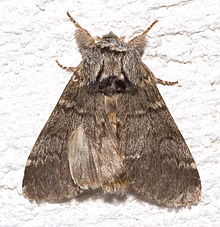Drymonia ruficornis
| Drymonia ruficornis | |
|---|---|

| |
| Scientific classification | |
| Domain: | Eukaryota |
| Kingdom: | Animalia |
| Phylum: | Arthropoda |
| Class: | Insecta |
| Order: | Lepidoptera |
| Superfamily: | Noctuoidea |
| Family: | Notodontidae |
| Genus: | Drymonia |
| Species: | D. ruficornis
|
| Binomial name | |
| Drymonia ruficornis (Hufnagel, 1766)
| |
Drymonia ruficornis, the lunar marbled brown, is a moth of the family Notodontidae. It is found in Central and Southern Europe and Anatolia.

Description
[edit]The wingspan is 35–40 mm. The fore wings are dark fuscous, almost blackish, with a short white line near the base; the central third is white clouded with the ground colour and limited by white edged black wavy lines. There is a black crescent just above the centre of the wing. Hind wings smoky grey with a pale curved line. Drymonia dodonaea is very similar.
Technical description
[edit]Thorax greyish brown to light grey, abdomen light. brown. Forewing dark grey-brown, the dark pre-and postdiscal zigzag bands as in querna but closer together, particularly at the hind margin, edged with white on the proximal and distal sides respectively; the median area between the transverse bands paler grey, bearing a sharp black luniform discal spot ; in the marginal area a whitish undulate line, which is frequently obsolete. Hindwing light grey-brown. In the southern districts, from southern Central Europe southward, a uniformly darker form predominates, grisea Turati (45e), m which the median area of the forewing is also darkened. Another form, which we call ab.lunula.nov . (45e), is intermediate between grisea and true chaonia [ruficornis] ; the whitish colour is restricted to the outer half of the median area beyond the cell and usually interrupted in the centre into a costal and a hindmarginal patch. This aberration likewise belongs to the southern districts. . Egg green. Larva pale green, with 4 equidistant chrome-yellow longitudinal lines, of which the 2 dorsal ones are sometimes whitish, the lateral ones on a level with the black-edged spiracles. Pupa black-brown with lighter segmental incisions; in the ground in a cell lined with silk. [1]
Biology
[edit]The moth flies from April to June depending on the location.
References
[edit]- ^ Seitz, A., 1913, in Seitz, Gross-Schmett. Erde 6: 22., The Macrolepidoptera of the Palearctic Fauna 2. Volume: The Palearctic Bombyces & Sphinges. pdf
 This article incorporates text from this source, which is in the public domain.
This article incorporates text from this source, which is in the public domain.
- ^ "Robinson, G. S., P. R. Ackery, I. J. Kitching, G. W. Beccaloni & L. M. Hernández, 2010. HOSTS - A Database of the World's Lepidopteran Hostplants. Natural History Museum, London".
Further reading
[edit]- South R. (1907) The Moths of the British Isles, (First Series), Frederick Warne & Co. Ltd., London & NY: 359 pp. online (as chaonia (Denis & Schiffermüller, 1775))
External links
[edit]- Lunar marbled brown on UKmoths
- Lepidoptera of Belgium Archived 2017-03-08 at the Wayback Machine
- Lepiforum.de
- Vlindernet (in Dutch)
